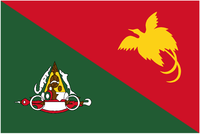East Sepik Province
| East Sepik | |
|---|---|

|
|
| geography | |
| Country: | Papua New Guinea |
| Waters: | Pacific Ocean |
| Islands: | (approx. 10; including New Guinea ) |
| Geographical location: | 4 ° 20 ′ S , 143 ° 15 ′ E |
| Basic data | |
| Surface: | 42,800 km² |
| Residents: | 450,530 |
| Population density: | 11 inhabitants / km² |
| Capital: | Wewak |
| Situation map | |
East Sepik is the name of one of the 21 provinces of Papua New Guinea . It is around 42,800 km² and has around 450,530 inhabitants. The capital is Wewak with 37,825 inhabitants in 2011. The neighboring provinces of East Sepik are Madang in the east, Enga in the south, Hela in the southwest and Sandaun in the west.
East Sepik is named after the largest river in the country, the Sepik . The lower and middle reaches of the river are very attractive and are one of the most visited parts of the country by tourists. In front of the mouth of the Sepik near the east coast of New Guinea lies the small group of islands of the Le Maire Islands .
East Sepik formed a province with West Sepik until 1968 . After that, the borders between the two Sepik provinces were changed several times. Today East Sepik protrudes into West Sepik in a wedge shape, so that the river basin runs in a province as possible. West Sepik is now called Sandaun and, in contrast to East Sepik, with its rugged coast is almost untouched by tourism.
The coast of East Sepik consists in the east of its course strongly changing alluvial land. Further to the west, the coast is characterized by steeply rising mountains and without natural harbors. The little fertile land is used intensively for growing coffee .
The central importance in East Sepik is undoubtedly the river, which has been the main trade route for many centuries. The tribes along the river have developed an artistic creativity that is unparalleled in all of Melanesia . The German researcher Otto Finsch was the first European to sail the Sepik in 1885 and named it after the wife of the then German Emperor Wilhelm I. Kaiserin Augusta River .
population
Some of the better-known peoples of East Sepik Province include the Arapesh and Mundugumor ; The American ethnologist Margaret Mead published a comparative study on the subject of aggression on both of them in the 1930s (see the Mead-Freeman controversy ). The social psychologist Erich Fromm assigned them to the "life-affirming societies", whose cultures are characterized by a pronounced sense of community with great social equality, friendly child rearing, tolerant sexual morality and a low tendency to aggression. (see also: "War and Peace" in pre-state societies )
The Arapesh exchange for a fixed ritual with neighboring Abelam that a yam - Cult maintain. The Yatmul are considered to be the most creative of the area. The small people of the peaceful Washkuk live in the mountains south of the river.
90 local languages are spoken in the province, some of which belong to the Torricelli language family ; around 30,000 residents speak Arapesh languages.
economy
East Sepik Province is relatively underdeveloped economically. In addition to fishing , agriculture plays a role. Sago , taro , yams , coffee , cocoa , coconut and betel nuts are grown . In addition, the arts and crafts ( wood carving , ceramics , basket weaving ), whose products are sold to tourists , are important.
Districts and LLGs
East Sepik Province is divided into six districts. Each district consists of one or more "areas at the local administrative level", Local Level Government (LLG) Areas , which are divided into Rural (rural) or Urban (urban) LLGs.
| District | Administrative center | Designation of the LLG areas |
|---|---|---|
| Ambunti-Dreikikir district | Ambunti | Ambunti Rural |
| Tunap-Hunstein Range Rural | ||
| Gawanga Rural | ||
| Dreikikir Rural | ||
| Angoram District | Angoram | Angoram-Middle Sepik Rural |
| Keram Rural | ||
| Karawari Rural | ||
| Marienberg-Lower Sepik Rural | ||
| Yuat Rural | ||
| Maprik District | Maprik | Silly Mamblep Rural |
| Bumbuita Muhiang Rural | ||
| Maprik Wora Rural | ||
| Yamil Tamaui Rural | ||
| Wewak District | Wewak | Boikin Dagua Rural |
| Turubu Rural | ||
| Wewak Islands Rural | ||
| Wewak Rural | ||
| Wewak Urban | ||
| Wosera-Gawi District | Wosera | Burui-Kunai Rural |
| Gawi Rural | ||
| North Wosera Rural | ||
| South Wosera Rural | ||
| Yangoru-Saussia District | Yangoru | East Yangoru Rural |
| Numbo Rural | ||
| Sausso Rural | ||
| West Yangoru Rural |
literature
- Heiner Wesemann: Papua New Guinea. Niugini. Stone Age Cultures on the Way to the 20th Century. DuMont, Cologne 1985, ISBN 3-7701-1322-5 ( DuMont culture travel guide ).
Web links
- Brief introduction: Papua New Guinea: Karawari (East Sepik). Pacific Island Travel, Netherlands, accessed April 27, 2014 (with some pictures).
Individual evidence
- ↑ Erich Fromm: Anatomy of human destructiveness . From the American by Liselotte et al. Ernst Mickel, 86th - 100th thousand edition, Rowohlt, Reinbek near Hamburg 1977, ISBN 3-499-17052-3 , pp. 191-192.
- ^ A b Charlie Higgins, John Titmus: East Sepik Earthquake & Mount Pago Volcano. United Nations Disaster Assessment and Coordination Team, Mission Report, September 2002, p. 5 ( ( Page no longer available , search in web archives ) Info: The link was automatically marked as defective. Please check the link according to the instructions and then remove this notice. ).
- ↑ Ethnologue entry: Arapesh. In: Ethnologue: Languages of the World . 2013, accessed April 27, 2014.
- ^ National Statistical Office of Papua New Guinea


